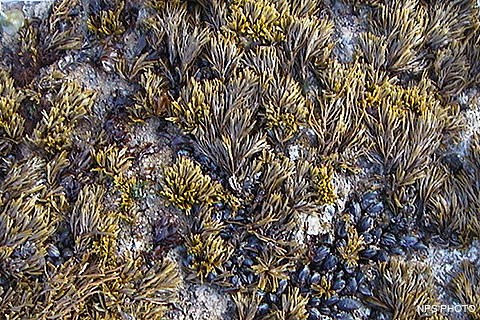|
With close to 130 kilometers (80 miles) of coastline, Point Reyes National Seashore has an abundance of species of algae, and a few species of marine plants. Seagrasses and kelp are "living habitats" that serve as nutrient filters and provide understory and ground cover for planktivorous fish, clams, and urchins, and a physical substrate for other invertebrates and algae. Seagrasses and kelps also provide spawning and nursery habitats for forage fish and juvenile crustaceans. 
SeagrassesSeagrasses are marine flowering plants that grow in large patches, or beds, in relatively shallow waters, such as those found in Drakes Bay, Tomales Bay, Drakes Estero, and Estero de Limantour. There are three species of sea grass found in these waters: Common eelgrass (Zostera marina), Scouler's surfgrass (Phyllospadix scouleri), and Torrey's surfgrass (Phyllospadix torreyi). The eelgrass is most likely to be found growing on soft substrates in sheltered bays, whereas the surfgrass tends to grow in rocky intertidal areas. Seagrasses have long, narrow leaves, and are so named for their resemblance to terrestrial grasses. Unlike kelp and other seaweeds, which are algae, seagrasses are vascular plants that produce flowers and seeds. These eelgrass beds provide important habitat for a variety of organisms, including snails, sea stars, anemones, crabs, and clams. 
AlgaeThe name "algae" is given to a group of organisms of mixed affinity, but the word itself has no taxonomic significance. Not all algae are even found in the plant kingdom. Most algae do not have vascular tissue, a high level of organ differentiation, or protective layers of cells surrounding their reproductive structures. Most algae do make their own food through photosynthesis, although a few algae—such as Euglena—must locate and engulf their food. The size of algae range from tiny microscopic life to giant ocean kelps, and they live in the driest deserts, the coldest tundras, and all types of waters. At Point Reyes National Seashore most algae are found on rock surfaces, covering the surface of ponds, and laced around the intertidal zone (marine algae). And some algae have developed a rather unique partnership with fungi to form a variety of lichens. Bull kelpPeople walking along the park's beaches will also likely come across long whip-like kelp, commonly called bull kelp. This kelp might look like a vascular plant due to its size, but it is a species of large, brown algae; and algae are members of the Protista kingdom. Growing up from the ocean floor about 2–30 meters, and as much as 20–30 cm above the ocean's surface. Kelp does not have roots. Instead, it is secured by holdfasts that lock onto substrates made of rock, or cobble. Although it functions in a way like a root, holdfasts do not absorb nutrients. Its "stem," or stipe, grows upward from the holdfast; attached to the stipe are leaves or fronds, where photosynthesis takes place. Gas bladders (pneumatocysts) keep the top parts of the kelp afloat. Two kinds of kelp grow on the eastern Pacific coast: giant kelp (Macrocystis pyrifera) and bull kelp (Nereocystis luetkeana), but only the bull kelp is found in the waters off of Point Reyes. Giant kelp, a perennial, has a pneumatocyst on each blade. Giant kelp has been known to live as much as seven years. Bull kelp, on the other hand, is an annual plant and has only one pneumatocyst holding up its many blades. Kelps of all species produce spores, which are released and develop into microscopic male or female plants on low intertidal or subtidal rocks. These produce eggs and sperm. Fertilized eggs grow very quickly to complete the cycle as they grow to become new large kelps. Kelp forests provide important habitat for a variety of species, from microscopic plankton to marine invertebrates, such as snails and sea urchin, to marine mammals, including sea lions and sea otters. Each part of the kelp—the holdfast at the ocean floor, in the middle along the stipe, and above the water in the canopy formed by the fronds—provides a home for one species or another. The population dynamics between sea otters and sea urchins are particularly important to the health and stability of kelp forests. Sea urchins like kelp—a lot—and, if their populations get too big, they may graze a kelp forest to death, creating what is referred to as an "urchin barren." And, if they remain and do not move on or are not predated upon, they may also inhibit the kelp's ability to grow again in that area. Sea otters like sea urchins—a lot—which is a good thing, because they can keep the urchin population under control, thus helping to preserve the kelp forests. As of 2020, sea otters are infrequent visitors to the waters surrounding Point Reyes. Common Seaweeds of Point Reyes Photo GalleryIn 2014, Dr. Kathy Ann Miller from the University of California, Berkeley's University and Jepson Herbaria surveyed and photographed seaweeds at Point Reyes. Many of these photos are available in a gallery she created. Species ListAlgae and Marine Plants of Point Reyes National Seashore (48 KB PDF) Science & Research Project SummariesFrom 2006 to 2018, Point Reyes National Seashore and Pacific Coast Science and Learning Center (PCSLC) staff and communication interns assisted scientists conducting research through the PCSLC and the San Francisco Bay Area Inventory & Monitoring Network to produce a series of Resource Project Summaries, three of which were about marine plants and algae at Point Reyes. These one- to two-page summaries provide information about the questions that the researchers hoped to answer, details about the project and methods, and the results of the research projects in a way that is easy to understand.
|
Last updated: March 30, 2025
